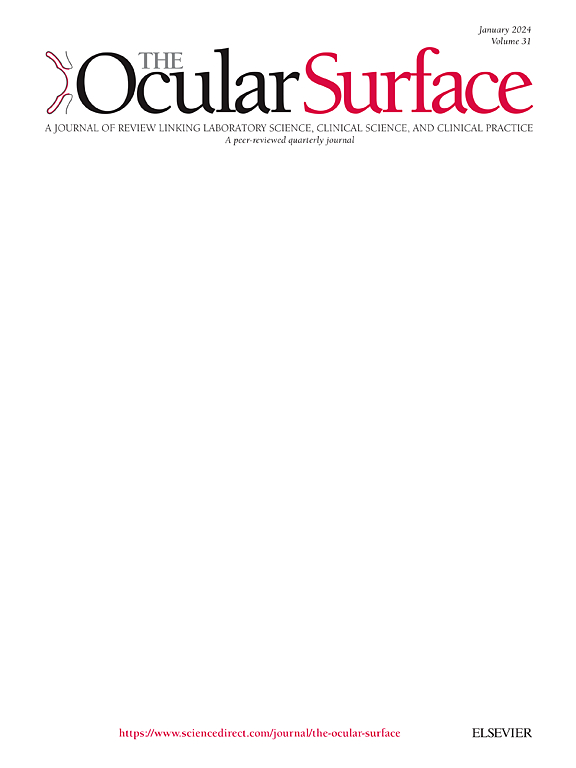Efficacy of eyelid warming devices as first-step treatment in meibomian gland dysfunction: A systematic review with meta-analysis
IF 5.6
1区 医学
Q1 OPHTHALMOLOGY
引用次数: 0
Abstract
Purpose
To investigate the efficacy of eyelid warming devices as first-step treatment in patients with meibomian gland dysfunction (MGD).
Methods
A systematic review with meta-analysis of RCTs, reporting the effects eyelid warming devices in 3 databases, PubMed, Scopus and Web of Science, was performed according to the PRISMA statement.
Results
Seven studies including 367 patients, and 440 eyes were analysed. The overall efficacy did not significantly favor either group when comparing eyelid warming devices to the control groups or warm towel compresses, nor between moisture chamber devices and warm compress devices. However, the change in OSDI questionnaire (SMD 0.91; 95 % CI: 0.44 to 1.39; P = 0.0002) and NIBUT (SMD 1.10; 95 % CI: 0.61 to 1.59; P < 0.0001) were significantly favorable for eyelid warming devices compared to the control groups. Similar results were obtained for tear film stability (SMD 0.97; 95 % CI: 0.32 to 1.61; P = 0.003) when comparing eyelid warming devices to warm towel compresses. Specifically, the sensitivity analysis of these groups revealed that changes in OSDI questionnaire (MD 9.41; 95 % CI: 1.70 to 17.13; P = 0.02; I2 = 49 %) and NIBUT (MD 2.24; 95 % CI: 1.20 to 3.28; P < 0.0001; I2 = 71 %) were significantly favorable for eyelid warming devices. When comparing moisture chamber devices and warm compress devices, only the change in TBUT (SMD 0.75; 95 % CI: 0.23 to 1.28; P = 0.005; I2 = 30 %) were significantly favorable for moisture chamber goggles.
Conclusions
Despite their limited overall efficacy, eyelid warming devices significantly reduce OSDI questionnaire and improve NIBUT compared to controls or warm towel compress groups. Evidence remains insufficient to confirm whether moisture chamber devices provide better outcomes than warm compress devices. Further well-designed RCTs are needed to confirm these findings.
眼睑温热装置作为睑板腺功能障碍第一步治疗的疗效:一项系统综述和meta分析。
目的:探讨眼睑温热装置作为睑板腺功能障碍(MGD)患者第一步治疗的疗效。方法:根据PRISMA声明对PubMed、Scopus和Web of Science 3个数据库中报道眼睑升温装置效果的随机对照试验进行系统评价和meta分析。结果:分析了7项研究,367例患者,440只眼。当将眼睑加热装置与对照组或热毛巾进行比较时,或将湿室装置与热敷装置进行比较时,两组的总体效果都不明显。然而,OSDI问卷的变化(SMD 0.91;95% CI: 0.44 ~ 1.39;P = 0.0002)和NIBUT (SMD 1.10;95% CI: 0.61 ~ 1.59;P < 0.0001)明显优于对照组。泪膜稳定性(SMD 0.97;95% CI: 0.32 ~ 1.61;P = 0.003)。具体而言,这些组的敏感性分析显示,OSDI问卷的变化(MD 9.41;95% CI: 1.70 ~ 17.13;P = 0.02;I2 = 49%)和NIBUT (MD 2.24;95% CI: 1.20 ~ 3.28;P < 0.0001;I2 = 71%)明显支持眼睑温热装置。对比湿室装置和热敷装置,只有TBUT的变化(SMD 0.75;95% CI: 0.23 ~ 1.28;P = 0.005;I2 = 30%)显著有利于湿室护目镜。结论:尽管整体疗效有限,但与对照组或温巾敷组相比,眼睑温热装置可显著降低OSDI问卷,改善NIBUT。证据仍然不足以证实湿室装置是否比热敷装置提供更好的结果。需要进一步精心设计的随机对照试验来证实这些发现。
本文章由计算机程序翻译,如有差异,请以英文原文为准。
求助全文
约1分钟内获得全文
求助全文
来源期刊

Ocular Surface
医学-眼科学
CiteScore
11.60
自引率
14.10%
发文量
97
审稿时长
39 days
期刊介绍:
The Ocular Surface, a quarterly, a peer-reviewed journal, is an authoritative resource that integrates and interprets major findings in diverse fields related to the ocular surface, including ophthalmology, optometry, genetics, molecular biology, pharmacology, immunology, infectious disease, and epidemiology. Its critical review articles cover the most current knowledge on medical and surgical management of ocular surface pathology, new understandings of ocular surface physiology, the meaning of recent discoveries on how the ocular surface responds to injury and disease, and updates on drug and device development. The journal also publishes select original research reports and articles describing cutting-edge techniques and technology in the field.
Benefits to authors
We also provide many author benefits, such as free PDFs, a liberal copyright policy, special discounts on Elsevier publications and much more. Please click here for more information on our author services.
Please see our Guide for Authors for information on article submission. If you require any further information or help, please visit our Support Center
 求助内容:
求助内容: 应助结果提醒方式:
应助结果提醒方式:


